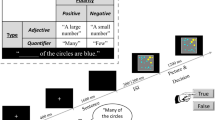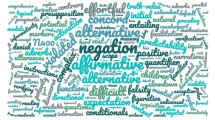Abstract
Studies on the brain’s response to positive and negative stimuli using non-invasive techniques such as fMRI and PET scans have been widely researched. The use of fMRI in particular, to study sentence polarity detection in the brain, has become a captivating field. This paper analyzed fMRI data of affirmative and negative sentence processing and developed a model using a correlation-based subset evaluator and NBTree classification to classify sentence polarity with an average accuracy of 92.9%. Further, the accuracy of the result is enhanced up to 100% using SVM-RFE and Rotation Forest. Our analysis of selected voxel sets in the brain showed that the calcarine sulcus and right and left dorsolateral prefrontal cortices play a significant role in determining sentence polarity, while areas such as the right posterior pre-central sulcus, right supramarginal gyrus, and right frontal eye fields have a limited contribution.













Similar content being viewed by others
Data Availability
Thedataset analysed during the current study are available in the public repository, and the link for the same is: http://www.cs.cmu.edu/afs/cs.cmu.edu/project/theo-81/www/.
References
Pandey P, Jha BK, Sinha N. Analyzing cognitive states using fMRI data. Procedia Comp Sci. 2016;90:35–41.
Sair HI, Agarwal S, Pillai JJ. Application of resting state functional MR imaging to presurgical mapping: language mapping. Neuroimag Clin. 2017;27(4):635–44.
Kaan E, Swaab TY. The brain circuitry of syntactic comprehension. Trends Cogn Sci. 2002;6(8):350–6. https://doi.org/10.1016/s1364-6613(02)01947-2.
Fiveash A, Thompson WF, Badcock NA, McArthur G. Syntactic processing in music and language: effects of interrupting auditory streams with alternating timbres. Int J Psychophysiol. 2018;129:31–40.
Yang Y, Wang J, Bailer C, Cherkassky V, Just MA. Commonality of neural representations of sentences across languages: predicting brain activation during Portuguese sentence comprehension using an English-based model of brain function. Neuroimage. 2017;146:658–66.
Feng S, Qi R, Yang J, Yu A, Yang Y. Neural correlates for nouns and verbs in phrases during syntactic and semantic processing: an fMRI study. J Neurolin. 2020;53: 100860.
Meyer L, Friederici AD. Neural systems underlying the processing of complex sentences. In: Neurobiology of language. Academic Press; 2016. p. 597–606.
Rogalsky C. The role of the anterior temporal lobe in sentence processing. In: Neurobiology of Language. Academic Press; 2016. p. 587–95.
Yokoyama S, Maki H, Hashimoto Y, Toma M, Kawashima R. Mechanism of case processing in the brain: an fMRI study. PLoS ONE. 2012;7(7):e40474. https://doi.org/10.1371/journal.pone.0040474.
Haegeman L. The syntax of negation. Cambridge: Cambridge Univerisity Press; 1995.
Mayo R, Schul Y, Burnstein E. “I am not guilty” vs “I am innocent”: Successful negation may depend on the schema used for its encoding. J Exp Soc Psychol. 2004;40(4):433–49.
Zwaan, R. A. (2012). The experiential view of language comprehension: How is negation represented. Higher level language processes in the brain: Inference and comprehension processes, 255
Carpenter PA, Just MA, Keller TA, Eddy WF, Thulborn KR. Time course of fMRI-activation in language and spatial networks during sentence comprehension. Neuroimage. 1999;10(2):216–24.
Hasegawa M, Carpenter PA, Just MA. An fMRI study of bilingual sentence comprehension and workload. Neuroimage. 2002;15(3):647–60.
Tettamanti M, Manenti R, Della Rosa PA, Falini A, Perani D, Cappa SF, Moro A. Negation in the brain: modulating action representations. Neuroimage. 2008;43(2):358–67.
Christensen KR. Negative and affirmative sentences increase activation in different areas in the brain. J Neurol. 2009;22(1):1–17.
Bahlmann J, Mueller JL, Makuuchi M, Friederici AD. Perisylvian functional connectivity during processing of sentential negation. Front Psychol. 2011;2:104.
Kumar U, Padakannaya P, Mishra RK, Khetrapal CL. Distinctive neural signatures for negative sentences in Hindi: an fMRI study. Brain Imaging Behav. 2013;7(2):91–101.
http://www.cs.cmu.edu/afs/cs.cmu.edu/project/theo-81/www/. Accessed 31 Dec 2022
Gupta KO, Chatur PN. Gradient self-weighting linear collaborative discriminant regression classification for human cognitive states classification. Mach Vis Appl. 2020;31:1–16.
Wen Z, Yu T, Yu Z, Li Y. Grouped sparse Bayesian learning for voxel selection in multivoxel pattern analysis of fMRI data. Neuroimage. 2019;184:417–30.
Kasabov NK. Deep Learning and Deep Knowledge Representation of fMRI Data. In: Time-Space Spiking Neural Networks and Brain-Inspired Artificial Intelligence. Berlin, Heidelberg: Springer; 2019. p. 361–95.
Wang, X., & Mitchell, T. (2002). Detecting cognitive states using machine learning. Iterim working paperWhiteld ML, Sherlock G, Saldanha A, Murray JI, Ball CA, Alexander KE, Matese JC, Perou CM, Hurt MM, Brown PO, Botstein.
Eddy W, Fitzgerald M, Genovese C, Lazar N, Mockus A, Welling J. The Challenge of functional magnetic resonance imaging. J Comput Graph Stat. 1999;8(3):545–58. https://doi.org/10.2307/1390875.
Hall, M. A. (1998) Correlation-based feature subset selection for machine learning. Thesis submitted in partial fulfillment of the requirements of the degree of Doctor of Philosophy at the University of Waikato
Tsamardinos I, Borboudakis G, Katsogridakis P, Pratikakis P, Christophides V. A greedy feature selection algorithm for Big Data of high dimensionality. Mach Learn. 2019;108(2):149–202.
Kohavi R. Scaling up the accuracy of naive-bayes classifiers: A decision-tree hybrid. In Kdd. 1996;96:202–7.
Rodriguez JJ, Kuncheva LI, Alonso CJ. Rotation forest: a new classifier ensemble method. IEEE Trans Pattern Anal Mach Intell. 2006;28(10):1619–30.
Shieh MD, Yang CC. Multiclass SVM-RFE for product form feature selection. Expert Syst Appl. 2008;35(1–2):531–41.
Behroozi M, Daliri MR. RDLPFC area of the brain encodes sentence polarity: a study using fMRI. Brain Imaging Behav. 2015;9(2):178–89.
Kasabov NK. NeuCube: A spiking neural network architecture for mapping, learning and understanding of spatio-temporal brain data. Neural Netw. 2014;52:62–76.
Doborjeh, M. G., Capecci, E., & Kasabov, N. (2014, December). Classification and segmentation of fMRI spatio-temporal brain data with a NeuCube evolving spiking neural network model. In 2014 IEEE Symposium on Evolving and Autonomous Learning Systems (EALS) (pp. 73–80). IEEE.
Ranjan, A., Singh, A. K., Thakur, A. K., Mishra, R. B., & Singh, V. P. (2021). Sentential Negation Identification of FMRI Data Using k-NN. In: Machine Intelligence and Smart Systems: Proceedings of MISS 2020 (pp. 657–664). Springer Singapore
Ranjan A, Singh VP, Singh AK, Thakur AK, Mishra RB. Classifying brain state in sentence polarity exposure: An ANN model for fMRI data. RIA. 2020. https://doi.org/10.18280/ria.340315.
Ranjan A, Singh VP, Mishra RB, Thakur AK, Singh AK. Sentence polarity detection using stepwise greedy correlation based feature selection and random forests: an fMRI study. Journal of Neurolinguistics. 2021;59:100985.
Author information
Authors and Affiliations
Corresponding author
Ethics declarations
Conflict of interest
The authors declare they have no conflict of interest.
Additional information
Publisher's Note
Springer Nature remains neutral with regard to jurisdictional claims in published maps and institutional affiliations.
This article is part of the topical collection “Machine Intelligence and Smart Systems guest” edited by Manish Gupta and Shikha Agrawal.
Rights and permissions
Springer Nature or its licensor (e.g. a society or other partner) holds exclusive rights to this article under a publishing agreement with the author(s) or other rightsholder(s); author self-archiving of the accepted manuscript version of this article is solely governed by the terms of such publishing agreement and applicable law.
About this article
Cite this article
Ranjan, A., Singh, V.P. Affirmative and Negative Sentence Detection in the Brain Using SVM-RFE and Rotation Forest: An fMRI Study. SN COMPUT. SCI. 4, 332 (2023). https://doi.org/10.1007/s42979-023-01786-1
Received:
Accepted:
Published:
DOI: https://doi.org/10.1007/s42979-023-01786-1




